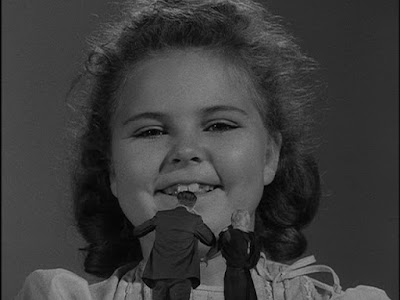The Twilight Zone excelled in telling tales of terror, exploring the darkest aspects of human existence in myriad ways. To celebrate the Halloween season, we’re counting down the 31 most frightening and unsettling moments from The Twilight Zone, one for each day of October. We’ll be revisiting some of the episodes we’ve already covered and looking ahead to episodes from the final three seasons of the series. -JP
#18 - A Child’s Playthings, from “Stopover in a Quiet Town,” season five, episode
150
Written
by Earl Hamner, Jr., directed by Ron Winston, starring Barry Nelson, Nancy
Malone
Frequent contributing writer Earl
Hamner, Jr. was a truly unique voice on the series and his idiosyncratic style
shines through in many of his efforts for the show. Hamner arrived in the third
season and displayed a skill in combining Southern folklore and rustic fantasy.
Occasionally, however, Hamner’s stories fell more in line with the type of modernistic
science fantasy typical of the series. Hamner’s fifth season episode, “Stopover
in a Quiet Town,” is perhaps his strongest script and certainly his most fondly
remembered episode by viewers of the show. This is primarily due to the
outlandish, yet nightmarish, ending to the episode. “Stopover in a Quiet Town”
concerns a drunken couple who awaken to find themselves trapped in what is
essentially a doll’s house. And who are the dolls? And, a more frightening
question, who is coming to play with the dolls? Haunted by the ephemeral,
lilting voice of a young girl, the couple try in vain to escape their makeshift
prison (for the exterior of the house proves as confining as the interior) only
to discover the true horror of their situation in a brilliant, climactic
reveal. Hamner uses elements of several previous episodes (including prominent
use of “Where is Everybody?” and “Five Characters in Search of an Exit,”) to
craft an atmospheric and engaging episode of supernatural persecution with an
effective, and seemingly requisite, twist ending.
Trivia:
-The story of supernatural persecution
was easily the most common story type on the series. Every regular series
writer tried their hand at it and the results are a number of the show’s
classic episodes, including “The After Hours,” “The Hitch-Hiker,” “The
Invaders,” “Perchance to Dream,” “The Dummy,” “Mirror Image,” and “Person or
Persons Unknown,” to name a few. Hamner previously attempted this type of story
with the earlier fifth season episode, “You Drive.” This episode type is quite
unlike the other story types common to the show, and shares more characteristics
with mystery and horror fiction than with science fiction, the latter of which
is a term often erroneous used to broadly characterize the series. Even as
early as the latter portion of the first season, the writers of the show began
to borrow from one another to create this type of episode and this allows for
fascinating juxtapositions between these familiar but versatile stories.

Stopover In A Quiet Town is actually a favorite of mine. It didn't used to be but it's grown on me. Barry Nelson and Nancy Malone make a credible couple. The MGM back lot is well utilized, and the escalating air of unease doesn't overwhelm the episode, by which I mean its characters. They accept the weirdness of their fate, one step at a time, as it were.
ReplyDeleteThe Noir In Broad Daylight tone is very much of its time (1964), especially as compared to many earlier episodes of the series. They're rerunning the Zone on MeTV and I (once again) watched What You Need last night, was struck once again by its "period" feel, which also made it feel timeless; while Stopover has a different vibe, it's no less "Zoney" because of it.
I just watched an episode of Land of the Giants where the crew is put in a doll house of sorts--an entire scale model town built by Percy Helton for his bratty granddaughter! Percy is always worth watching.
ReplyDeleteI'm glad MeTV brought that show back, even if it is on in the middle of the night. Know of any good Irwin Allen blogs out there?
ReplyDeleteThis episode is based on one of my own primal fears: being in a seemingly normal setting, but totally alone. (Except that in my nightmares, it's always night). One assumes that the couple in this episode both commit suicide shortly after the final fade out -- their situation is utterly hopeless, and the prospect of living on for decades as pets in what amounts to a glorified doll house would be appalling. Even worse are their acid, sharp-tongued natures, which would pretty well insure that neither would be very good company for the other in a never-ending crisis situation. Sartre's play "No Exit" (a possible alternate title for this episode) has the same theme: "Hell is other people".
ReplyDelete